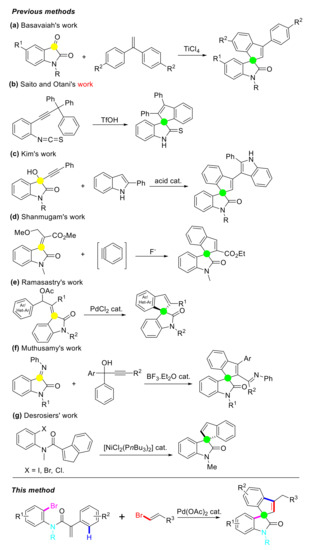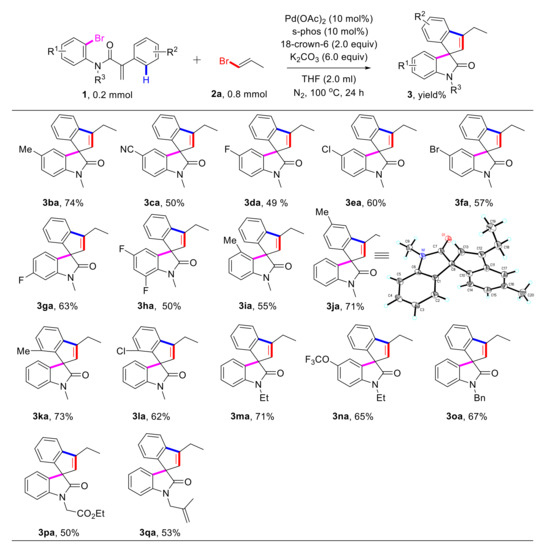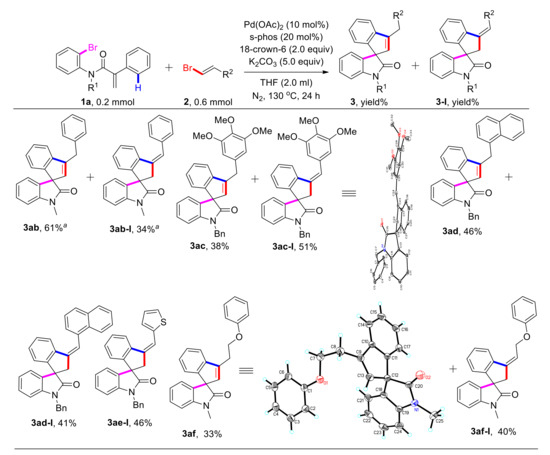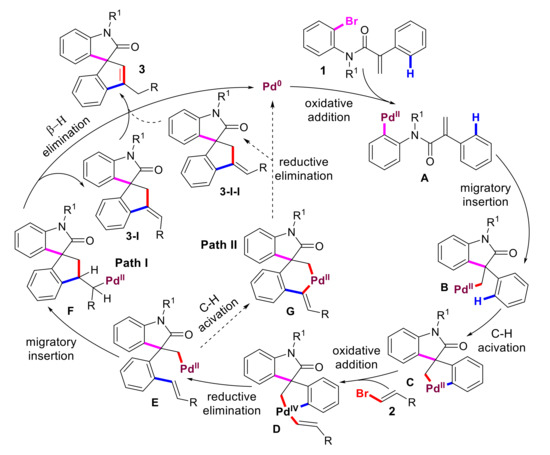Abstract
An expeditious approach to the construction of spiroindenyl-2-oxindoles was developed via a palladium-catalyzed spirocyclization reaction of 2-bromoarylamides with vinyl bromides. The reaction formed spiropalladacycles as the intermediates via carbopalladation and the C–H functionalization of 2-bromoarylamides. The spiropalladacycles reacted with vinyl bromides to form spiroindenyl-2-oxindoles. A Heck process rather than vinylic C–H functionalization was involved in the reaction.
1. Introduction
Spirooxindoles are ubiquitous in bioactive natural products and have found extensive applications in drug discovery [1,2,3,4,5,6,7]. On the other hand, spiroindenes have also gained considerable interest in medicinal chemistry [8,9,10,11,12,13]. The investigation of biological and pharmaceutical properties of spiroindenyl-2-oxindoles that contain both spiro-bridged indene and oxindole moieties is highly intriguing [14,15]. To achieve this, it is essential to develop efficient synthetic methods for the analysis of compounds of such a type. Currently, the reactions for the synthesis of spiroindenyl-2-oxindoles are rare, and the majority of them rely on the use of 3-substituted indoles as the starting materials (Figure 1a–f) [14,15,16,17,18,19]. It should be noted that Desrosiers and coworkers reported an elegant synthetic approach for spiroindenyl-2-oxindoles through nickel-catalyzed intramolecular Heck cyclization (Figure 1g) [20,21].

Figure 1.
Synthetic methods of spiroindenyl-2-oxindoles.
Over the past few years, domino Heck/C–H functionalization reactions have gained considerable interest and made noticeable progress in organic synthesis [22,23]. By using alkene-tethered aryl halides as substrates, the reactions of such a type undergo the oxidative addition of aryl halides to Pd0 and intramolecular carbopalladation of alkene moieties to form alkylpalladiumII species. The alkylpalladiumII species can cleave C–H bonds of an aryl group tethered to the alkene moiety to generate C,C-palladacycles. The palladacycles may undergo intramolecular cyclization [24,25,26,27,28,29,30,31,32,33,34,35] or be captured with external reagents [36,37,38,39,40,41,42,43,44,45,46,47,48,49,50,51,52,53,54,55]. These types of reactions not only represent a novel strategy to activate C–H bonds that are not in proximity to directing groups, but also provide easy access to complex polycyclic compounds. Notably, the reactions also open a new avenue for the synthesis of spirocyclic scaffolds. By the judicious design of alkene-tethered aryl halides substrates, spiropalladacycles can be formed by a domino Heck/C–H functionalization sequence. The resulting spiropalladacycles are very effective intermediates for the synthesis of spirocyclic compounds. During recent years, quite a few reactions of this type have been developed. Spiropalladacycles have undergone cyclization [30,31,32,33,34,35] and have been trapped by a variety of external reagents including diaziridinone [44], benzynes [45,46,47], carbenoids [48,49], alkynes [50,51], CH2Br2 [52], alkyl chlorides [53], and aryl iodides [54,55], affording various spirocyclic products.
2. Results and Discussion
2.1. Optimization of the Reaction Conditions
Herein, we report a new approach for the synthesis of spiroindenyl-2-oxindoles through domino Heck/C–H functionalization reactions. This work was inspired by the reaction of C(sp2), C(sp3)-palladacycle derived from ortho-iodomethoxybenzenes with vinyl bromides [56]. It should be mentioned that the reactions of 2-iodobiphenyls with vinyl bromides have also been reported [57,58]. The reactions also proceeded via C,C-palladacycle intermediates, which were captured by vinyl bromides to form 9-fluorenylidene products.
The research was commenced by investigating the reaction of model substrates acrylamide (1a) and 1-bromoprop-1-ene (2a) (Table 1). After an extensive condition survey, spiroindenyl-2-oxindoles 3aa was generated in a yield of 74% under the reaction conditions shown in entry 1. The optimal yield was obtained by using 18-crown-6, which promoted the reaction perhaps by enhancing the solubility of K2CO3 in THF (entry 2). Ligand s-phos played a crucial role in the reaction since its absence led to a very low yield and other phosphine ligands gave lower yields (entries 3–7). K2CO3 was an essential base, and only a trace amount of the product was observed when other bases such as Na2CO3 and KOAc were used (entries 8 and 9). Although 3aa was also formed when the reaction was carried out in other solvents, the yields were much lower (entries 10–12).

Table 1.
Optimization of the reaction conditions.
2.2. Substrate Scope for Acrylamides
Having developed an approach for the synthesis of spiroindenyl-2-oxindoles, we then probed its substrate scope (Scheme 1). We first examined the performance of acrylamides bearing different functionalities on the bromophenyl groups. The acrylamides containing an electron-donating methyl or electron-withdrawing cyano group underwent the cascade reaction (3ba and 3ca). Fluoro, chloro, and even bromo groups were well tolerated, and the corresponding spiroindenyl-2-oxindoles were formed in moderate yields (3da–3fa). The substituents on the other positions of the bromophenyl groups were also suitable (3ga–3ia). Furthermore, substrates bearing a substituent on the phenyl groups linked to the double bonds could also be transformed into spiroindenyl-2-oxindole products (3ja–3la). The structure of 3ja was confirmed by single crystal X-ray crystallography.

Scheme 1.
Acrylamide scope. All the reactions were carried out in a Schlenk tube in the presence of 1a (0.2 mmol), 2a (0.8 mmol), Pd(OAc)2 (10 mol%), s-phos (10 mol%), 18-crown-6 (2.0 equiv), K2CO3 (6.0 equiv), and THF (2.0 mL) at 100 °C for 24 h under N2.
Next, the reactions of acrylamide bearing different N-substituents were probed. A range of N-substituents, including the ethyl, benzyl 2-ethoxy-2-oxoethyl and 2-methylallyl group, were compatible, and a variety of spiroindenyl-2-oxindole derivatives were afforded (3ma–3qa). Finally, it should be noted that the substrate containing an ether linkage could also form the desired spirocyclic product 3ra (Scheme 2).

Scheme 2.
The reactions were carried out in a Schlenk tube in the presence of 1r (0.2 mmol), 2a (0.8 mmol), Pd(OAc)2 (10 mol%), s-phos (10 mol%), 18-crown-6 (2.0 equiv), K2CO3 (6.0 equiv), and THF (2.0 mL) at 100 °C for 24 h under N2.
2.3. Substrate Scope for Vinyl Bromides
The vinyl bromide scope was then explored (Scheme 3). When styryl bromide was allowed to react with 1a under the slightly modified standard conditions, spiroindenyl-2-oxindole 3ab and compound 3ab-I were obtained. The formation of 3ab-I should be due to the stabilization of the exocyclic double bond by the phenyl group. As expected, styryl bromide derivatives, such as trimethoxystyryl bromide and (E)-1-(2-bromovinyl)naphthalene, also gave two isomers (3ac and 3ac-I). The structure of 3ac-I was confirmed by single-crystal X-ray crystallography. It should be noted that the trimethoxyphenyl group was on the same side as the benzene ring, and the double bond in compound 3ac-I had Z-configuration. This structure provides crucial evidence regarding the mechanism of the reaction. (E)-2-(2-bromovinyl)thiophene was also reactive, and only the exocyclic double bond product (3ae-I) was obtained. Intriguingly, two products (3af and 3af-I) were also obtained in the reaction of alkylvinyl bromide 2f. The structure of 3af was also confirmed by single-crystal X-ray crystallography.

Scheme 3.
Vinyl bromide scope. All the reactions were carried out in a Schlenk tube in the presence of 1a (0.2 mmol), 2 (0.6 mmol), Pd(OAc)2 (10 mol%), s-phos (20 mol%), 18-crown-6 (2.0 equiv), K2CO3 (5.0 equiv), and THF (2.0 mL) at 130 °C for 24 h under N2. a 0.4 mmol vinyl bromide.
2.4. Mechanistic Studies
On the basis of the formation of the products and the previous reports [52,56,57,58], a tentative mechanism was proposed as shown in Scheme 4. The catalytic cycle starts with the oxidative addition of substrate 1 to Pd0 to form PdII species A, which is followed by intramolecular migratory insertion to give alkylPdII species B. The subsequent intramolecular C–H functionalization affords palladacycle C. C undergoes oxidative addition with 2-bromoalkenyl derivatives to form PdIV species D. The reductive elimination of D yields intermediate E. At this stage, E may undergo two pathways to form final product 3. Path I involves intermediate 3-I, which is formed through intramolecular migratory insertion and subsequent β-H elimination. Alternatively, the alkylPdII species of E may cleave the vinyl C–H bond to yield palladacycle G. G forms product 3-I-I and Pd0 by reductive elimination (path II). Both 3-I and 3-I-I can isomerize to yield final product 3. It is challenging to distinguish these two pathways. Fortunately, the mechanism can be deciphered based on the structure of intermediate 3ac-I. If the reaction undergoes path II, 3-I-I, which has E-configuration, should be formed. On the contrary, compound 3-I with Z-configuration should be generated for path I. The Z-configuration of 3ac-I indicates that the reaction proceeds via path I.

Scheme 4.
Proposed mechanism.
3. Materials and Methods
3.1. General Information
Pd(OAc)2 was purchased from Strem Chemicals (Newburyport, MA, USA). The 1H NMR and 13C NMR spectra were recorded on a Bruker ARX400 instrument (400 MHz) or a Bruker DRX-600 instrument (600 MHz). High-resolution mass spectra were measured on a Bruker MicroTOF II ESI-TOF mass spectrometer. NMR spectra were recorded in CDCl3. The 1H NMR spectra were referenced to residual CHCl3 at 7.26 ppm, and 13C NMR spectra were referenced to the central peak of CDCl3 at 77.0 ppm. Chemical shifts (δ) are reported in ppm and coupling constants (J) are in Hertz (Hz). Multiplicities are reported using the following abbreviations: s = singlet, d = doublet, t = triplet, q = quartet, and m = multiplet.
3.2. Experimental Procedures
Synthesis of Spiroindenyl-2-Oxindoles (Please see Supplementary Materials).
- (a)
- A 25 mL Schlenk-type tube (with a Teflon screw cap and a side arm) equipped with a magnetic stir bar was charged with Pd(OAc)2 (0.02 mmol, 4.4 mg, 0.1 equiv), s-phos (0.02 mmol, 8.2 mg, 0.1 equiv), K2CO3 (1.2 mmol, 165.9 mg, 6.0 equiv), 18-crown-6 (0.4 mmol, 105.7 mg, 2.0 equiv), acrylamide 1a (0.2 mmol, 63.2 mg, 1.0 equiv), 1-bromo-1-propene 2a (0.8 mmol, 96.8 mg, 4.0 equiv), and THF (2.0 mL). The reaction mixture was frozen with liquid nitrogen, and then, the tube was evacuated and backfilled with nitrogen (6 times). The reaction tube was put into an oil bath and then heated to 100 °C. The reaction mixture was stirred at 100 °C for 24 h. After being cooled down to room temperature, the reaction mixture was diluted with EtOAc (15 mL), washed with brine (3 times), dried over Na2SO4, and concentrated in vacuo. The residue was purified by preparative silica gel TLC with petroleum ether/ethyl acetate (ether/ethyl acetate 25:1) to afford 3aa (71%, 39.0 mg).
- (b)
- A 25 mL Schlenk-type tube (with a Teflon screw cap and a side arm) equipped with a magnetic stir bar was charged with Pd(OAc)2 (0.02 mmol, 4.4 mg, 0.1 equiv), s-phos (0.04 mmol, 16.4 mg, 0.2 equiv) K2CO3 (1.0 mmol, 138.2 mg, 5.0 equiv), 18-crown-6 (0.4 mmol, 105.7 mg, 2.0 equiv), acrylamide 1a (0.2 mmol, 63.2 mg, 1.0 equiv), β-bromostyrene 2b (0.6 mmol, 109.8 mg, 3.0 equiv), and THF (2.0 mL). The reaction mixture was frozen with liquid nitrogen and then the tube was evacuated and backfilled with nitrogen (6 times). The reaction tube was put into an oil bath and then heated to 130 °C. The reaction mixture was stirred at 130 °C for 24 h. After being cooled down to room temperature, the reaction mixture was diluted with EtOAc (15 mL), washed with brine (3 times), dried over Na2SO4, and concentrated in vacuo. The residue was purified by preparative silica gel TLC with petroleum ether/ethyl acetate (ether/ethyl acetate 25:1) to afford 3ab (61%, 41.2 mg) and 3ab-l (34%, 22.9 mg).
4. Conclusions
In summary, we developed a palladium-catalyzed spirocyclization reaction between 2-bromoarylamides and vinyl bromides via a cascade Heck/C–H functionalization process. The reaction forms spiropalladacycles as the intermediate by carbopalladation and C–H functionalization of 2-bromoarylamides. The resulting spiropalladacycles react with vinyl bromides effectively and spiroindenyl-2-oxindoles are formed as the final products. The Z-configuration of the precursor was identified, and it indicates that a Heck process instead of a vinylic C–H functionalization is involved in the reaction. This reaction provides a novel and effective strategy for the construction of spiroindenyl-2-oxindoles.
Supplementary Materials
The following are available online. Synthetic procedure of starting materials, procedure and spectral data of products, copies of 1H-NMR, 13C-NMR spectra.
Author Contributions
Conceptualization, S.Y. and Y.Z.; methodology, S.Y.; validation, S.Y.; formal analysis, S.Y.; investigation, S.Y.; resources, Y.Z.; data curation, S.Y.; writing—original draft preparation, Y.Z.; writing—review and editing, S.Y. and Y.Z.; supervision, Y.Z.; project administration, Y.Z.; funding acquisition, Y.Z. All authors have read and agreed to the published version of the manuscript.
Funding
This research was funded by the Natural Science Foundation of China (No. 21971196).
Institutional Review Board Statement
Not applicable.
Informed Consent Statement
Not applicable.
Data Availability Statement
The data presented in this study are available on request from the corresponding author.
Conflicts of Interest
The authors declare no conflict of interest.
Sample Availability
Samples of the compounds are not available from the authors.
References
- Galliford, C.V.; Scheidt, K.A. Pyrrolidinyl-Spirooxindole Natural Products as Inspirations for the Development of Potential Therapeutic Agents. Angew. Chem. Int. Ed. 2007, 46, 8748–8758. [Google Scholar] [CrossRef] [PubMed]
- Bindra, J.S. Chapter 2 Oxindole Alkaloids. Alkaloids: Chem. Physiol. 1973, 14, 83. [Google Scholar]
- Ding, Y.; Tian, Z.; Zhu, N. Research Progress of Antibacterial Spiro-compounds. Chin. J. Org. Chem. 2010, 30, 1156. [Google Scholar]
- Ye, N.; Chen, H.; Wold, E.A.; Shi, P.-Y.; Zhou, J. Therapeutic Potential of Spirooxindoles as Antiviral Agents. ACS Infect. Dis. 2016, 2, 382–392. [Google Scholar] [CrossRef] [PubMed]
- Ma, Y.; Fan, C. Progress in the Synthesis of Spirotryprostatin Alkaloids. Chin. J. Org. Chem. 2016, 36, 2380. [Google Scholar] [CrossRef]
- Yu, B.; Yu, D.-Q.; Liu, H.-M. Spirooxindoles: Promising scaffolds for anticancer agents. Eur. J. Med. Chem. 2015, 97, 673–698. [Google Scholar] [CrossRef] [PubMed]
- Guo, Y.; Meng, C.; Liu, X.; Xu, D.; Xia, A. An Efficient Asymmetric Construction of Novel Spiro-Fused 2-Oxindoles/α-Methy-paraconic Ester. Chin. J. Org. Chem. 2017, 37, 2782. [Google Scholar] [CrossRef][Green Version]
- Kolanos, R.; Siripurapu, U.; Pullagurla, M.; Riaz, M.; Setola, V.; Roth, B.L.; Dukat, M.; Glennon, R.A. Binding of isotryptamines and indenes at h5-HT6 serotonin receptors. Bioorganic Med. Chem. Lett. 2005, 15, 1987–1991. [Google Scholar] [CrossRef]
- Watanabe, N.; Nakagawa, H.; Ikeno, A.; Minato, H.; Kohayakawa, C.; Tsuji, J.-I. 4-(4-Alkylpiperazin-1-yl)phenyl group: A novel class of basic side chains for selective estrogen receptor modulators. Bioorganic Med. Chem. Lett. 2003, 13, 4317–4320. [Google Scholar] [CrossRef] [PubMed]
- Lin, Y.; Du, D. Recent Advances in Squaramide-Catalyzed Asymmetric Cascade Reactions for the Synthesis of Spirooxindoles. Chin. J. Org. Chem. 2020, 40, 3214. [Google Scholar] [CrossRef]
- Karaguni, I.-M.; Glusenkamp, K.-H.; Langerak, A.; Geisen, C.; Ullrich, V.; Winde, G.; Moroy, T.; Muller, O. New In-dene-Derivatives with Anti-Proliferative Properties. Bioorg. Med. Chem. Lett. 2002, 12, 709. [Google Scholar] [CrossRef]
- Evans, B.E.; Leighton, J.L.; Rittle, K.E.; Gilbert, K.F.; Lundell, G.F.; Gould, N.P.; Hobbs, D.W.; DiPardo, R.M.; Veber, D.F.; Pettibone, D.J.; et al. Orally active, nonpeptide oxytocin antagonists. J. Med. Chem. 1992, 35, 3919–3927. [Google Scholar] [CrossRef]
- Liu, Y.; Zhang, X.; Miao, Z. Research Progress on the Synthetic Method of Five-Membered Spirooxindole Derivatives at C-3 Position. Chin. J. Org. Chem. 2021, 41, 3965. [Google Scholar] [CrossRef]
- Basavaiah, D.; Reddy, K.R. Simple and One-Pot Protocol for Synthesis of Indene-spiro-oxindoles Involving Tandem Prins and Friedel−Crafts Reactions. Org. Lett. 2007, 9, 57–60. [Google Scholar] [CrossRef] [PubMed]
- Roh, H.J.; Seo, D.Y.; Ryu, J.Y.; Lee, J.; Kim, J.N. Synthesis of spiroindenyl-2-oxindoles by montmorillonite K-10-catalyzed tandem Friedel-Crafts alkenylation/hydroarylation of propargylic alcohols with sterically hindered and electron-rich arenes. Tetrahedron Lett. 2017, 58, 4094–4098. [Google Scholar] [CrossRef]
- Saito, T.; Sonoki, Y.; Otani, T.; Kutsumura, N. Triflic acid-promoted cycloisomerization of 2-alkynylphenyl isothiocyanates and isocyanates: A novel synthetic method for a variety of indole derivatives. Org. Biomol. Chem. 2014, 12, 8398–8407. [Google Scholar] [CrossRef]
- Meerakrishna, R.S.; Athira, M.; Shanmugam, P. Unusual [3+2] Spiroannulation and Creation of Stereogenic Quaternary Center at C-3 of Oxindole via Addition of (Het)arynes to Isomerized Morita-Baylis-Hillman Adduct of Isatin. ChemistrySelect 2018, 3, 874–878. [Google Scholar] [CrossRef]
- Muthusamy, S.; Balasubramani, A.; Suresh, E. Boron Trifluoride Catalyzed Divergent Synthesis of 3-Alkenyl-3-amino-2-oxindoles and Spiro-indeneindolones from Propargylic Alcohols. Adv. Synth. Catal. 2018, 361, 702–707. [Google Scholar] [CrossRef]
- Singh, B.; Bankar, S.K.; Kumar, K.; Ramasastry, S.S.V. Palladium-catalysed 5-endo-trig Allylic (Hetero)arylation. Chem. Sci. 2020, 11, 4948. [Google Scholar] [CrossRef] [PubMed]
- Desrosiers, J.-N.; Hie, L.; Biswas, S.; Zatolochnaya, O.V.; Rodriguez, S.; Lee, H.; Grinberg, N.; Haddad, N.; Yee, N.K.; Garg, N.K.; et al. Construction of Quaternary Stereocenters by Nickel-Catalyzed Heck Cyclization Reactions. Angew. Chem. Int. Ed. 2016, 55, 11921–11924. [Google Scholar] [CrossRef] [PubMed]
- Desrosiers, J.-N.; Wen, J.; Tcyrulnikov, S.; Biswas, S.; Qu, B.; Hie, L.; Kurouski, D.; Wu, L.; Grinberg, N.; Haddad, N.; et al. Enantioselective Nickel-Catalyzed Mizoroki–Heck Cyclizations To Generate Quaternary Stereocenters. Org. Lett. 2017, 19, 3338–3341. [Google Scholar] [CrossRef] [PubMed]
- Mehta, V.P.; García-López, J.-A. σ-Alkyl-PdII Species for Remote C–H Functionalization. ChemCatChem 2017, 9, 1149. [Google Scholar] [CrossRef]
- Ping, Y.; Li, Y.; Zhu, J.; Kong, W. Construction of Quaternary Stereocenters by Palladium-Catalyzed Carbopalladation-Initiated Cascade Reactions. Angew. Chem. Int. Ed. 2019, 58, 1562. [Google Scholar] [CrossRef] [PubMed]
- Bunescu, A.; Piou, T.; Wang, Q.; Zhu, J. Pd-Catalyzed Dehydrogenative Aryl−Aryl Bond Formation via Double C(sp2)−H Bond Activation: Efficient Synthesis of [3,4]-Fused Oxindoles. Org. Lett. 2015, 17, 334. [Google Scholar] [CrossRef] [PubMed]
- Piou, T.; Bunescu, A.; Wang, Q.; Neuville, L.; Zhu, J. Palladium-Catalyzed through-Space C(sp3)−H and C(sp2)−H Bond Ac-tivation by 1,4-Palladium Migration: Efficient Synthesis of [3,4]-Fused Oxindoles. Angew. Chem. Int. Ed. 2013, 52, 12385. [Google Scholar] [CrossRef]
- Saha, N.; Wang, H.; Zhang, S.; Du, Y.; Zhu, D.; Hu, Y.; Huang, P.; Wen, S. Domino Carbopalladation/C–H Activation as a Quick Access to Polycyclic Frameworks. Org. Lett. 2018, 20, 712–715. [Google Scholar] [CrossRef]
- Brown, D.; Grigg, K.; Sridharan, V.; Tambyrajah, V. A palladium catalysed cascade cyclisation-friedel-crafts alkylation approach to angularly fused ring systems. Tetrahedron Lett. 1995, 36, 8137–8140. [Google Scholar] [CrossRef]
- Huang, Q.; Fazio, A.; Dai, G.; Campo, A.M.A.; Larock, R.C. Pd-Catalyzed Alkyl to Aryl Migration and Cyclization: An Efficient Synthesis of Fused Polycycles via Multiple C–H Activation. J. Am. Chem. Soc. 2004, 126, 7460–7461. [Google Scholar] [CrossRef]
- Wang, M.; Zhang, X.; Zhuang, Y.-X.; Xu, Y.-H.; Loh, T.-P. Pd-Catalyzed Intramolecular C–N Bond Cleavage, 1,4-Migration, sp3 C–H Activation, and Heck Reaction: Four Controllable Diverse Pathways Depending on the Judicious Choice of the Base and Ligand. J. Am. Chem. Soc. 2015, 137, 1341. [Google Scholar] [CrossRef]
- Piou, T.; Neuville, L.; Zhu, J. Activation of a C(sp3)−H Bond by a Transient s-Alkylpalladium(II) Complex: Synthesis of Spi-rooxindoles through a Palladium-Catalyzed Domino Carbopalladation/C(sp3)−C(sp3) Bond-Forming Process. Angew. Chem. Int. Ed. 2012, 51, 11561. [Google Scholar] [CrossRef]
- Ruck, R.T.; Huffman, M.A.; Kim, M.M.; Shevlin, M.; Kandur, W.V.; Davies, I.W. Palladium-Catalyzed Tandem Heck Re-action/C–H Functionalization—Preparation of Spiro-Indane-Oxindoles. Angew. Chem. Int. Ed. 2008, 47, 4711. [Google Scholar] [CrossRef] [PubMed]
- Ma, J.; Liu, T.-X.; Zhang, P.; Zhang, C.; Zhang, G. Palladium-catalyzed domino spirocyclization of [60]fullerene: Synthesis of diverse [60]fullerene-fused spiro[4,5]/[5,5] derivatives. Chem. Commun. 2020, 57, 49–52. [Google Scholar] [CrossRef] [PubMed]
- Grigg, R.; Fretwell, P.; Meerholtz, C.; Sridharan, V. Palladium catalysed synthesis of spiroindolines. Tetrahedron 1994, 50, 359–370. [Google Scholar] [CrossRef]
- Piou, T.; Neuville, L.; Zhu, J. Spirocyclization by Palladium-Catalyzed Domino Heck–Direct C–H Arylation Reactions: Syn-thesis of Spirodihydroquinolin-2-ones. Org. Lett. 2012, 14, 3760. [Google Scholar] [CrossRef] [PubMed]
- Satyanarayana, G.; Maichle-Mössmer, C.; Maier, M.E. Formation of Pentacyclic Structures by a Domino Sequence on Cyclic Enamides. Chem. Commun. 2009, 1571. [Google Scholar] [CrossRef]
- Zhou, L.; Qiao, S.; Zhou, F.; Xuchen, X.; Deng, G.; Yang, Y.; Liang, Y. α-Oxocarboxylic Acids as Three-Carbon InsertionUnits for Palladium-Catalyzed Decarboxylative Cascade Synthesis of Diverse Fused Heteropolycycles. Org. Lett. 2021, 23, 2878. [Google Scholar] [CrossRef] [PubMed]
- Luo, X.; Zhou, L.; Lu, H.; Deng, G.; Liang, Y.; Yang, C.; Yang, Y. Palladium-Catalyzed Domino Heck/C–H Activa-tion/Decarboxylation: A Rapid Entry to Fused Isoquinolinediones and Isoquinolinones. Org. Lett. 2019, 21, 9960. [Google Scholar] [CrossRef] [PubMed]
- Rodríguez, J.F.; Marchese, A.D.; Lautens, M. Palladium-Catalyzed Synthesis of Dihydrobenzoindolones via C–H Bond Ac-tivation and Alkyne Insertion. Org. Lett. 2018, 20, 4367. [Google Scholar] [CrossRef] [PubMed]
- Zhang, Y.; Sun, Y.-K.; Chang, Y.-P.; Shao, H.; Zhao, Y.-M. Palladium-Catalyzed Cascade Carbonylative Annulation between Alkene-tethered Aryl Iodides and Carbon Monoxide. Chem. Commun. 2021, 57, 7023. [Google Scholar] [CrossRef] [PubMed]
- Zhang, M.; Zhou, F.; Xuchen, X.; Zhou, L.; Deng, G.; Liang, Y.; Yang, Y. A palladium-catalyzed Heck/[4+1] decarboxylative cyclization cascade to access diverse heteropolycycles by using α-bromoacrylic acids as C1 insertion units. Org. Chem. Front. 2021, 8, 5687–5692. [Google Scholar] [CrossRef]
- Sickert, M.; Weinstabl, H.; Peters, B.; Hou, X.; Lautens, M. Intermolecular Domino Reaction of Two Aryl Iodides Involving Two C-H Functionalizations. Angew. Chem. Int. Ed. 2014, 53, 5147–5151. [Google Scholar] [CrossRef] [PubMed]
- Yao, T.; He, D. Palladium-Catalyzed Domino Heck/Aryne Carbopalladation/C–H Functionalization: Synthesis of Heterocy-cle-Fused 9,10-Dihydrophenanthrenes. Org. Lett. 2017, 19, 842. [Google Scholar] [CrossRef]
- Lu, Z.; Hu, C.; Guo, J.; Li, J.; Cui, Y.; Jia, Y. Water-Controlled Regioselectivity of Pd-Catalyzed Domino Reaction Involving a C–H Activation Process: Rapid Synthesis of Diverse Carbo- and Heterocyclic Skeletons. Org. Lett. 2009, 12, 480–483. [Google Scholar] [CrossRef] [PubMed]
- Zheng, H.; Zhu, Y.; Shi, Y. Palladium(0)-Catalyzed Heck Reaction/C-H Activation/Amination Sequence with Diaziridinone: A Facile Approach to Indolines. Angew. Chem. Int. Ed. 2014, 53, 11280–11284. [Google Scholar] [CrossRef] [PubMed]
- Pérez-Gómez, M.; García-López, J.-A. Trapping σ-Alkyl–Palladium(II) Intermediates with Arynes Encompassing Intramolec-ular C–H Activation: Spirobiaryls through Pd-Catalyzed Cascade Reactions. Angew. Chem. Int. Ed. 2016, 55, 14389. [Google Scholar] [CrossRef]
- Yoon, H.; Lossouarn, A.; Landau, F.; Lautens, M. Pd-Catalyzed Spirocyclization via C–H Activation and Benzyne Insertion. Org. Lett. 2016, 18, 6324–6327. [Google Scholar] [CrossRef]
- Pérez-Gómez, M.; Navarro, L.; Saura-Llamas, I.; Bautista, D.; Lautens, M.; García-López, J.-A. Synthesis and Reactivity of Model Intermediates Proposed for the Pd-Catalyzed Remote C–H Functionalization of N-(2-Haloaryl)acrylamides. Organometallics 2017, 36, 4465–4476. [Google Scholar] [CrossRef]
- Pérez-Gómez, M.; Hernández-Ponte, S.; Bautista, D.; García-López, J.-A. Synthesis of spiro-oxoindoles through Pd-catalyzed remote C–H alkylation using α-diazocarbonyl compounds. Chem. Commun. 2017, 53, 2842–2845. [Google Scholar] [CrossRef] [PubMed]
- Liu, J.-G.; Chen, W.-W.; Gu, C.-X.; Xu, B.; Xu, M.-H. Access to Spiroindolines and Spirodihydrobenzofurans via Pd-Catalyzed Domino Heck Spiroyclization through C–H Activation and Carbene Insertion. Org. Lett. 2018, 20, 2728–2732. [Google Scholar] [CrossRef] [PubMed]
- Yoon, H.; Rölz, M.; Landau, F.; Lautens, M. Palladium-Catalyzed Spirocyclization through C–H Activation and Regioselective Alkyne Insertion. Angew. Chem. Int. Ed. 2017, 56, 10920–10923. [Google Scholar] [CrossRef] [PubMed]
- Franzoni, I.; Yoon, H.; García-López, J.-A.; Poblador-Bahamonde, A.I.; Lautens, M. Exploring the mechanism of the Pd-catalyzed spirocyclization reaction: A combined DFT and experimental study. Chem. Sci. 2017, 9, 1496–1509. [Google Scholar] [CrossRef]
- Shao, C.; Wu, Z.; Ji, X.; Zhou, B.; Zhang, Y. An approach to spirooxindoles via palladium-catalyzed remote C–H activation and dual alkylation with CH2Br2. Chem. Commun. 2017, 53, 10429–10432. [Google Scholar] [CrossRef]
- Ye, J.; Shi, Z.; Sperger, T.; Yasukawa, Y.; Kingston, C.; Schoenebeck, F.; Lautens, M. Remote C–H Alkylation and C–C bond Cleavage Enabled by an in situ Generated Palladacycle. Nat. Chem. 2017, 9, 361. [Google Scholar] [CrossRef] [PubMed]
- Luo, X.; Xu, Y.; Xiao, G.; Liu, W.; Qian, C.; Deng, G.; Song, J.; Liang, Y.; Yang, C. Palladium-Catalyzed Tandem Reaction of Three Aryl Iodides Involving Triple C–H Activation. Org. Lett. 2018, 20, 2997–3000. [Google Scholar] [CrossRef] [PubMed]
- Luo, X.; Li, W.; Lu, H.; Deng, G.; Yang, Y.; Yang, C.; Liang, Y. Palladium-catalyzed cascade synthesis of spirocyclic oxindoles via regioselective C2-H arylation and C8-H alkylation of naphthalene ring. Chin. Chem. Lett. 2020, 32, 713–716. [Google Scholar] [CrossRef]
- Dyker, G. Palladium-Catalyzed Carbon-Hydrogen Activation at Methoxy Groups for Cross-coupling Reactions: A New Ap-proach to Substituted Benzo[b]furans. J. Org. Chem. 1993, 58, 6426. [Google Scholar] [CrossRef]
- Yang, S.; Zhang, Y. Synthesis of 9-Fluorenylidenes via Pd-Catalyzed C–H Vinylation with Vinyl Bromides. Org. Lett. 2021, 23, 7746–7750. [Google Scholar] [CrossRef] [PubMed]
- Zhao, Y.-H.; Wang, J.-L.; Zhou, Y.-B.; Liu, M.-C.; Wu, H.-Y. Palladium-catalyzed coupling reaction of 2-iodobiphenyls with alkenyl bromides for the construction of 9-(diorganomethylidene)fluorenes. Org. Biomol. Chem. 2021, 19, 8250–8253. [Google Scholar] [CrossRef] [PubMed]
Publisher’s Note: MDPI stays neutral with regard to jurisdictional claims in published maps and institutional affiliations. |
© 2021 by the authors. Licensee MDPI, Basel, Switzerland. This article is an open access article distributed under the terms and conditions of the Creative Commons Attribution (CC BY) license (https://creativecommons.org/licenses/by/4.0/).
